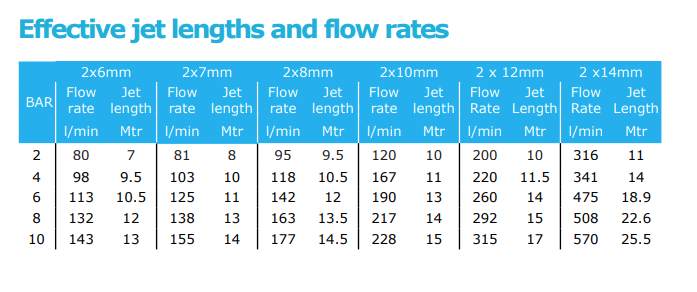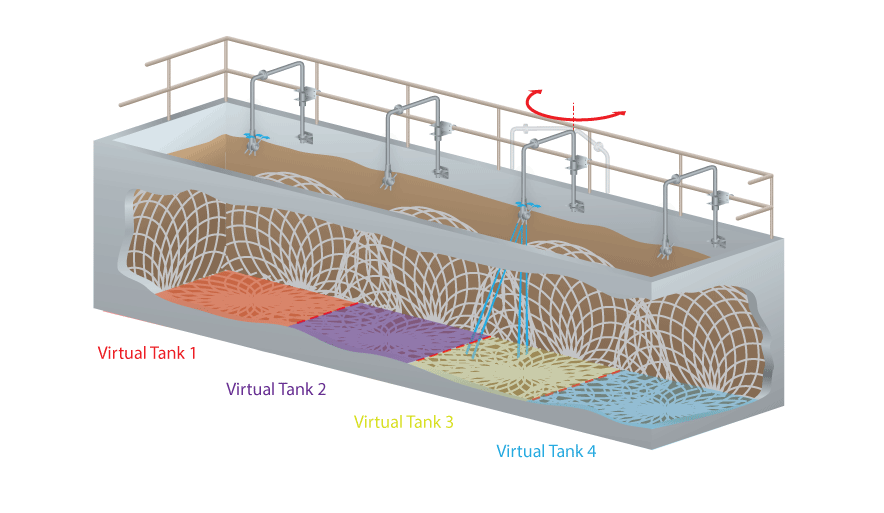Sizing a StormBlaster™ rotary jet for stormtank cleaning
The StormBlaster™ rotary jet cleaners can clean an amazing range of size and shapes of stormwater attenuation tanks. The units themselves come with a variety of nozzle sizes, resulting in different jet lengths and flow rates. They can operate at different pressures and we often install multiple units into tanks to clean larger tanks. Over the years, we have developed some specific protocols for designing these systems to clean almost any storm tank you can imagine.
There are a few limiting factors on some types of tanks that we cannot clean e.g. in the unlikely event the tank has no drain gradient and we have covered those in a video here.
So what are the basic factors to consider in system design?
Jet length
Each of the StormBlasters will be operating at a certain fluid pressure and will have a certain nozzle size that will dictate its effective cleaning jet length. Ideally, we want to position the tank cleaner at the top of the tank and in the centre. We want each part of the tank to be well within the range of the jet length. So we measure from the point of the nozzle to the furthest point it is going to clean to ensure that the furthest distance is within range.

It might not be possible to get optimal positioning, particularly on open tanks, but we will cover positioning later on.
Overall water usage
Each cleaning head will have a cleaning cycle and it will have a flow rate depending on the pressure you are running it at. It must run through its complete cleaning cycle to reach every part of the tank.

So, if you multiply the cleaning cycle time by the flow rate, you're going to get an overall water usage per cleaning head.
It might be tempting to reduce this as much as possible but there is a limit on by how much it can be reduced. You need a certain amount of water overall per m² of the tank floor and the reason for this is we need to have a certain amount of water moving around within the system to allow it to drain effectively. We have developed a protocol and formulas for this. While we always work to reduce the amount of water used, there is a minimum amount needed for it to work effectively.
Pumps and pressure
In an ideal world, we want to have all the jet cleaners operating at around 8 to 10 bar fluid pressure. This increases the overall flow rate through the nozzles but it also speeds up the cycle time. So they complete their cleaning cycle quicker at 8 bar than they would, say, at 4 bar. And when you multiply the increased flow rate by the decreased cycle time, what we actually find is they're most efficient, i.e. they use the least water at about 8 to 10 bar.
And they also have more effective cleaning because they have more powerful jets. Really, we want to get between 8 and 10 bar fluid pressure at the required flow rates on site. And this often involves the installation of a booster pump to get our pressure up there for optimal pressure working.
Multiple tank cleaners
With very large tanks what we tend to do is divide them into smaller virtual tank sections. Each section will be treated as being cleaned by its own StormBlaster™ rotary jet cleaner. We ensure that each part of the each virtual tank is within range of the jets and conforms to the other design protocols. There are no actual tank modifications, the divisions are virtual tanks. The virtual tanks' rotary cleaning jets from will each overspill into each other which just serves to give a bit of extra cleaning. As long as each virtual tank can be cleaned effectively, according to the protocols, by its StormBlaster™, any cleaning that does occur into the adjacent tanks is just bonus cleaning.

Also when we install multiple tank cleaners, we tend to run them in sequence rather than at same time and this reduces the pump duty. If we had, say, 4 StormBlasters in a big tank, we would just run them in sequence. Each would only need the flow rate and pressure for each one of them. If we run them all at same time, they would need 4 times that and they’d need a bigger pump but there is no need to run them all at the same time.
As a very rough rule of thumb, you're going to need one StormBlaster™ per about every 120 m2 of tank floor roughly.
Positioning and access
So as noted, we ideally want to have the tank cleaners on the central line of the tank. This means more of the tank or the virtual tank is within range of the effective cleaning jet length, which means you can use fewer tank cleaners. This gives optimal usage of those cleaning jets on the central line.
However, this may not be possible in open tanks that are quite wide. On roof tanks, we can just position the tank cleaner through the roof and it can be removed for access via a manhole cover, so we can get that ideal central positioning. On open tanks, it may not be possible. What we tend to do is position the StormBlasters™ on swing arms. The tank cleaner can be moved back to the side of the tank so it can be removed for maintenance.
The practical length of swing arms is about 2 to 3 m. So if we've got a tank above, say, 6 m in width, then we cannot position the StormBlaster™ on the central line. This is not a problem. It just means it is not quite optimal. We may need to modify the design slightly but an effective cleaning solution can still be delivered.